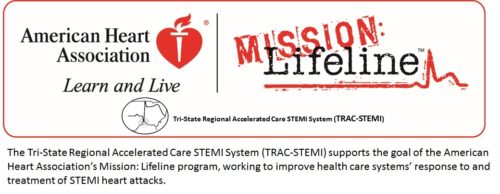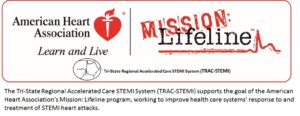
Mission: Lifeline® – A Proactive System of Care to Improve Cardiac Outcomes
The American Heart Association (AHA) developed Mission: Lifeline® to transform cardiac outcomes for patients with both STEMI (ST-elevation myocardial infarction) and NSTE-ACS (non-ST-elevation acute coronary syndrome) by connecting healthcare providers, emergency medical services (EMS) personnel, and community residents.1 University of Cincinnati (UC) Medical Center has participated in Mission: Lifeline® since 2007. In the Spring of 2014, with leadership from Timothy Smith, MD, assistant professor of medicine, department of interventional cardiology and critical care medicine, the Greater Cincinnati/Northern Kentucky successfully submitted and received a grant from the AHA and Duke Clinical Research Institute (DCRI) to participate in  the Accelerator project: a national outcomes research study to increase the implementation of STEMI care systems with the goal of improving use of reperfusion therapy and clinical outcomes for patients in 12 large metropolitan regions.2
the Accelerator project: a national outcomes research study to increase the implementation of STEMI care systems with the goal of improving use of reperfusion therapy and clinical outcomes for patients in 12 large metropolitan regions.2
At the culmination of the Accelerator II project, Dr. Smith expects that acute MI outcomes in the Cincinnati region will equal national Mission: Lifeline® standards for prehospital and hospital providers.3 He cites North Carolina, where statewide, coordinated regional care improved the speed and the rate of myocardial perfusion (at 119 hospitals, with 9.4 million people across 53,000 square miles): 89% of patients who presented directly to percutaneous coronary intervention (PCI) hospitals were treated within 90 minutes and 52% within 60 minutes.4 Dr. Smith describes the role of UC Medical Center and the six other hospital systems that include 22 regional hospitals in the project: “representatives of the major hospitals talk biweekly, and the entire region meets quarterly to update processes for physicians, hospitals, and emergency medical services personnel.” These groups review and discuss regional data, protocols, guidelines and processes that determine when patients should bypass non-PCI hospitals in favor of a PCI center, which patients should be air-lifted or ground-transported, and who should be given thrombolytics or the opportunity for PCI.
“The clinical pieces of a program like Mission: Lifeline® are just as important to arrange in a competitive market: the clinical/technical factors are driven by standardized protocols in accordance with national guidelines and algorithms,” says Dr. Smith. Competition aside, all participants are fully committed to the project’s goals — “reduced times to reperfusion for people in our region having heart attacks, and better outcomes and survival for them.” Achieving and sustaining such goals are keys to the success of Cincinnati/Northern Kentucky region.
According to Dr. Smith, “Mission: Lifeline® also addresses barriers to care by encouraging public education.” For example, out-of-hospital cardiac arrests (OHCAs) are the third-leading cause of death when they are separated from other cardiovascular causes of death.5 The potential benefits of public education are considerable, if more patients than the approximately 41% of OHCA patients who received bystander cardiopulmonary resuscitation could be treated.5 Likewise, greater public access to automated external defibrillators could also aid OHCAs, as 25% of these events occur in public locations with witnesses who could perform defibrillation while waiting for medical assistance.6 Dr. Smith envisions expanding the systems of care approach to include OHCAs and all cardiovascular emergencies in which time and expertise are critical.
Dr. Smith points out that UC Medical Center has shown its commitment to, and ability to deliver, exceptional cardiac care as a recipient of the AHA’s “Mission: Lifeline STEMI Receiving Gold Quality Achievement Award” for daily excellence and performing at the highest level in 2015. According to Dr. Smith, “we consistently met door-to-balloon times—less than 90 minutes—maintained 24/7 availability of catheterization laboratory personnel, and were willing to take all heart attack victims in a timely fashion. Our commitment to the people we serve and to physicians in the region is to just say yes when someone is in need of advanced cardiovascular care.”
References:
- Mission: Lifeline. Available at: http://www.heart.org/HEARTORG/HealthcareProfessional/Mission-Lifeline-Home-Page_UCM_305495_SubHomePage.jsp. Accessed March 5, 2016.
- Bagai A, Al-Khalidi HR, Sherwood MW, et al. Regional systems of care demonstration project: Mission: Lifeline STEMI Systems Accelerator: design and methodology. Am Heart J. 2014;167(1):15–21.e3.
- Mission: Lifeline metric measures. Available at: http://www.slideshare.net/Hiltz/mission-lifeline-stemi-and-cardiac-resuscitation-systems-of-care-launch-webinar-slides. Accessed March 5, 2016.
- Jollis JG, Al-Khalidi HR, Monk L, et al, on behalf of the Regional Approach to Cardiovascular Emergencies (RACE) Investigators. Expansion of a regional ST-segment-elevation myocardial infarction system to an entire state. Circulation. 2012;126(2):189–195.
- Roger VL, Go AS, Lloyd-Jones DM, et al, on behalf of the American Heart Association Statistics Committee and Stroke Statistics Subcommittee. Heart disease and stroke statistics—2012 update. A report from the American Heart Association. Circulation. 2013;125(1):e2-e220.
- McClure A, Nichol G. Toward efficient improvements in resuscitation for cardiac arrest. Circulation. 2010;122:567-560.
 Timothy Smith, MD
Timothy Smith, MD
Assistant Professor of Medicine
Interventional Cardiovascular and Critical Care Medicine
(513) 558-6804
smith5ty@ucmail.uc.edu
Connect with Timothy Smith, MD on Doximity
Leave a reply →
